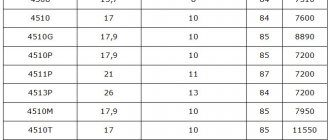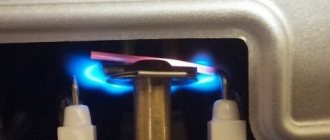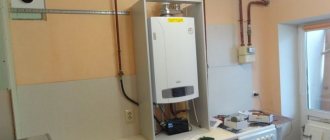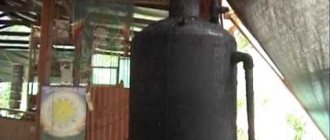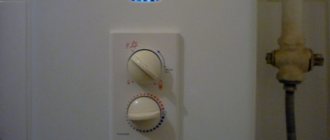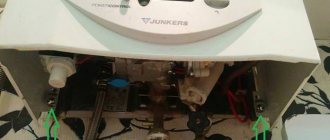To install a heating system, you will need a source of thermal energy. This can be main or liquefied gas, firewood, electricity or liquid fuel. The most profitable option is gas. But not all settlements have mains gas. In this case, use its liquefied version. If you decide to use a gas cylinder for heating, you need to familiarize yourself in advance with the advantages and disadvantages of such systems, as well as understand the nuances of their design.
Bottled gas heating and what is it?
Heating systems that use liquefied gas to heat the coolant are the type we are describing. If methane gas circulates in the central line, then the cylinders are filled with propane or a mixture of butane and propane. Heating with gas cylinders in a private house is done if it is not possible to connect to a centralized gas supply.
Such systems are used in houses with an area of 70-100 square meters. In this case, the building must be well insulated to minimize fuel consumption. Also, to save gas, it is recommended to use not only a boiler running on this fuel, but also electrical heating appliances.
Important! The fuel is in cylinders under high pressure, so disassembling or damaging the containers is prohibited.
Pros and cons of balloon heating
Gas heating from bottled gas has the following advantages:
- The cylinders contain fully purified fuel, which promotes complete combustion in the boiler chamber. As a result, no slag or ash remains.
- Gas-fired heating equipment does not need to be connected to power supply systems, so such heating can be called energy-independent.
- The heating system works stably and smoothly, and its operation is easy to manage.
- Ease of operation is an additional advantage of bottled gas heating.
- The price of gas is the lowest in comparison with other types of fuel.
- The efficiency of such a system is quite high and reaches 90-95%.
- If necessary, heating equipment can be converted to operate on mains gas.
- An impressive service life can also be considered one of the advantages of such heating.
Used cylinders can be sold on the secondary market to offset some of the costs. If you install a double-circuit boiler running on liquefied gas, you can not only heat the house, but also provide it with hot water supply.
The disadvantages of heating with propane or a mixture of propane and butane are the need to regularly refill gas storage tanks. In addition, for the correct and uninterrupted operation of the system, certain conditions must be created.
Economical ways to heat water
Hot water can be obtained in three economical ways:
• Minimum water flow with minimum gas supply to the burner.
• By adjusting the water flow while maintaining a constant gas supply to the burner.
• By adjusting the gas supply to the burner with a constant water flow.
The last two methods, combined with diluting hot water with a cold water tap, will be completely uneconomical.
The most profitable first method of adjustment. At the same time, gas and water consumption will be minimal. Perhaps this is the best solution for you in saving water, gas and paying for them.
The method is good, but it requires keeping the column in good and well-maintained condition with annual maintenance (MOT).
RECOMMENDED: How to save money on installing meters?
Connection diagram for gas cylinders to a heating boiler
To connect the cylinder to the boiler, a special reducer is used, which converts liquefied fuel into a gaseous state. It is in this form that it is supplied to the heating equipment. If several containers are used at once, then the same number of reducers will be needed to connect to each cylinder. This is much safer than connecting several containers at once through one common gearbox.
Important! If you use several cylinders, you can increase the operating interval of the equipment on one fuel fill.
To assemble the entire structure, a two-arm collector is used. This is a special ramp that divides all containers into two groups. One group is the main one. From it, gas enters the boiler first. The second group is the reserve group. It is used after the main group runs out of gas. Switching from one group to another occurs automatically. At the same time, a characteristic signal is heard. After refueling and connecting the tanks of the main group, the collector begins to consume fuel from these cylinders.
Gas equipment for home heating - burners for stoves and boilers
All containers with fuel are installed from the boiler at a distance of no closer than 200 cm. It is best to allocate a separate room for these purposes or fence off a compartment in the furnace room. It is prohibited to install cylinders in an uncovered place exposed to sunlight.
To connect containers, metal pipelines with a wall thickness of less than 2 mm are used. In the place where the pipes pass through the walls, protective cases are installed, and all openings are filled with foam. A durite hose is used to connect the pipeline to the heater.
Safety Recommendations
Converting the boiler and reconfiguring it to consume liquefied gas dictates the need to “reconfigure” your attitude towards the device for supplying and storing blue fuel.
You must remember that:
- Cylinders or gas tanks, which are gas storage tanks that supply fuel to household appliances as needed, need to be refilled periodically.
- To fill a group of cylinders or a gas holder with gas, you need to contact certified organizations that have equipment to record the weight of the gas in the cylinder and its actual volume in the gas holder.
- Filling closed gas tanks is carried out to 85% of the useful volume of the vessel. This reserve is necessary in case of thermal expansion of the fuel to avoid an explosion.
A non-hazardous situation that requires special attention when replenishing liquefied blue fuel reserves is the filling of liquid with a density different from the density of the previous liquid. Because of this difference, the remaining liquefied gas may not mix with the newly filled portion.
In the tank, due to the difference in density, a kind of two non-connecting sectors are formed, in each of which liquefied gas circulates. However, convective heat exchange will occur at the sector boundary after a short period. After the temperatures are equalized, the densities will be equal and the liquids will be able to mix.
Liquefied gas, like main gas, is a highly flammable, combustible liquid with a high flame propagation speed. To avoid catastrophic situations, you should strictly follow the operating rules and fill the cylinders no more than 85%
Usually this process, meaning direct mixing, is accompanied by intense evaporation of liquefied gas. To avoid associated losses, mixing devices should be used during the filling process. But it is better to choose a method that eliminates the above-described phenomenon.
Replenishing cylinders and gas tanks with blue fuel in general is a process that requires increased attention, otherwise problems can be very serious and even catastrophic. The rapid spread and evaporation of the liquefied gas mixture is recognized as a significant problem.
If the rules for the safe operation of gas-consuming equipment are not violated, main methane rarely explodes. This only happens with significant leaks, if the technical state of the gas in the surrounding space changes dramatically. For example, in a kitchen with obvious signs of a leak, instead of mandatory ventilation, they turn on the light.
When liquefied gas expands in a closed container due to external heating, it will necessarily explode if there is not enough space left in the container for its expansion. Blue fuel burns extremely intensely. Since the gas is quickly absorbed by the atmosphere, the combustion zone expands at high speed.
Components for cylinder heating systems
Heating using liquefied gas is done using the following components:
- heating equipment with a gas burner;
- reducers for connecting cylinders;
- fuel containers with a capacity of 50 liters;
- ramp;
- rubber-fabric sleeve for connecting the pipeline to the boiler;
- shut-off valves.
The connection diagram is very simple, so it can be implemented by hand. When choosing a suitable gas boiler, give preference to units operating at minimum pressure and maximum efficiency. Consider what type of fuel the boiler is designed for. There are units that run only on liquefied gas. But if in the future you plan to connect the main gas supply, then it is better to prefer universal models that can operate on different types of fuel.
The gas boiler burner must have narrow nozzles that are designed to operate under high pressure bottled gas conditions. Units designed to use mains gas have wide nozzles. If liquefied fuel is supplied through such devices, an accident may occur.
Boilers designed to operate on LPG (liquefied petroleum gas) have special nozzles and a gas valve. To independently convert a conventional boiler to operate using liquefied fuel, you will need to purchase the necessary parts.
Important nuance
There are two types of gas used in everyday life. More precisely, two compositions of the gas mixture. And the characteristics of these mixtures differ greatly:
Main gas, which consists of methane with an indicator - a strong-smelling component that allows you to quickly detect a leak. The main difference is that the mixture is lighter than air. Therefore, in a properly made furnace, a leak in the fittings is not a problem - the gas will simply go through the direct-flow system into the pipe, onto the street. A mixture of propane and butane is what is “packed” into cylinders at gas filling stations. This blend is better known as liquefied domestic gas
An important difference is that it weighs more than atmospheric air. As a result, in the event of a leak, it becomes very dangerous, since it can accumulate in the room or firebox of a stove converted to gas.
And even the presence of a gas tank does not help - the same propane-butane mixture is filled into it.
Accordingly, if there is a gas main near the house, you can make a project, a permit and bring the pipe into the house. And instead of a boiler with a system of pipes, batteries or water circuit registers, install a furnace in which to burn gas.
But if only a bottled gas supply option is available, then there is no place for homemade products. We need to go a little different way.
How to calculate gas consumption?
To calculate fuel consumption, you need to know the power of the heating equipment. When determining it, they use the rule that for every 10 square meters of heated area, a boiler power of 1 kW is required.
Autonomous heating system for a private house with a gas boiler
Thus, to heat a house with an area of 100 square meters, you need a boiler with a power of 10 kW. To generate 1 kW of thermal energy, approximately 0.12 cubic meters of gas per hour are consumed. To heat such a house for one hour you will need 1.2 m³ of fuel. Knowing this number, it is easy to calculate the daily fuel consumption. It will be 28.8 cubic meters.
At first glance, it seems that gas consumption is quite high. But these values are valid only for continuous operation of the boiler during the first warm-up of the system immediately after its startup. In the future, the equipment will operate in automatic mode and fuel consumption will decrease.
As a rule, to maintain the temperature in a house with an area of 100 square meters within 22°C at sub-zero temperatures outside, you will need about three cylinders of fuel per week. If at night the temperature is maintained 4-6 degrees below daytime, then fuel consumption will be reduced by a whole cylinder.
If the containers are used to heat a summer cottage for seasonal residence, then the operation of the boiler can be adjusted so that during the absence of the owners in the building the temperature is maintained within +5°C. This will ensure economical fuel consumption. As a result, to heat a small house for 7-10 days you will need only one cylinder of liquefied fuel.
Safety precautions when using gas cylinders
If liquefied gas is used to heat your home, you must adhere to the following safety requirements:
- When the system freezes, it is prohibited to use open flames to heat the cylinders. In case of any fire within the house, fuel containers must be removed as far as possible from the fire.
- If a separate room cannot be allocated for fuel containers, then it is impossible to install the cylinders near the cellar or basement, because the gas can fall down. If it gets into the basement, it can lead to an explosive situation or poisoning of people who go down into the room.
- When connecting containers, a leak meter must be installed to minimize the likelihood of explosion and fire.
- It is prohibited to store empty cylinders in the house. For these purposes, a separate building must be allocated, located no closer than 10 meters from the house.
Attention! To ensure safety, the system is inspected and preventive maintenance performed every 4 years.
The nuances of using cylinders in winter
If bottled gas is used to heat a country house, then in winter you need to take care to protect the fuel from freezing. This is especially true for buildings for seasonal use, for example, dachas, when the owners come to the house only on weekends.
If fuel containers are stored outside the house, then at sub-zero temperatures the pressure in them decreases. If the pressure drops significantly, heating equipment may stop working. To avoid this situation, containers with fuel during cold weather are installed in a special cabinet with a built-in ventilation system. Non-flammable insulation is used to insulate the cabinet.
If there is no such cabinet, then it is better to store containers with fuel in an extension to the house, in which there is no heating, but a positive temperature is constantly maintained due to good insulation. Do not forget about other safety requirements when choosing a suitable place to install cylinders for the winter.
Heating a private house with gas cylinders: consumption of the necessary fuel
As practice shows and consumer reviews indicate, for a house of 100 m², approximately 3 - 2 cylinders of gas per week are needed, provided that the capacity is 50 liters. From this calculation you can determine how much fuel you will need to heat your country house. For example, for a house of 200 m², the amount of gas will increase to 4 containers per week. If your house has an area of about 50 m2, then 1 cylinder will be enough for you.
It is possible to accurately calculate the fuel consumption of a boiler operating on bottled gas using the accompanying technical documentation, which is necessarily included in the kit by the responsible manufacturer.
